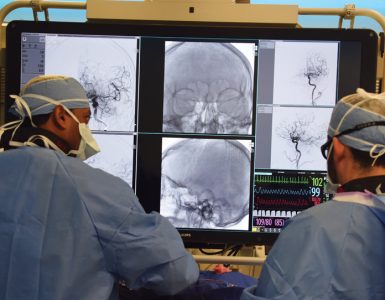In the tough war against glioblastoma, scientists are taking a cue from viruses on how to make the aggressive cancer more vulnerable to treatment.
Their target is SAMHD1, a protein which can protect us from viral infections by destroying an essential building block of DNA that viruses and cancer need to replicate.
But they’ve found SAMHD1 also has the seemingly contradictory skill of helping repair double-strand breaks in the DNA that if unrepaired can be lethal to any cell, including a cancer cell, and if mended incorrectly can result in genetic mutations that produce cancer.
“When the DNA breaks, that is what actually interrupts the DNA replication and also the synthesis of proteins, so a double-strand break is lethal for cells,” says Waaqo Daddacha, PhD, cancer biologist in the Department of Biochemistry and Molecular Biology at the Medical College of Georgia.
Cancer cells, which are reproducing much more rapidly than most normal cells, are replicating even faster, so are impacted even more by these DNA breaks, which is why fundamental therapies like radiation and some chemotherapy drugs used to treat cancers make these lethal breaks.
However, the aggressive brain cancer quickly becomes treatment-resistant and the average survival remains at about 15 months, Daddacha says.
Now Daddacha and his colleagues report in the journal Cancers their surprising finding that in glioblastoma in humans both SAMHD1 and the essential DNA building block dNTP, which it can destroy, are highly expressed, indicating SAMHD1’s likely importance to the brain tumor’s aggressiveness and raising questions about what it’s doing there.
They were expecting high levels of dNTP because cancers need a ready supply of this building block to keep up their rapid pace of replicating and spreading, Daddacha says. Since dNTP levels were high, they were also expecting low levels of SAMHD1 would be present and that increasing its levels would help protect against glioblastoma.
They would find the opposite to be true, indicating that like with so many innate properties cancer usurps, glioblastoma likely alters the function of SAMHD1.
Based on what they found, the scientists instead decided to reduce SAMHD1 levels and that’s where viruses’ skill at eliminating the multitasking protein came in.
Viruses deploy the protein viral protein X, or Vpx, to literally chop up SAMHD1 so they will have a ready supply of dNTP, a virus skill set first identified in HIV.
So, the scientific team used a virus-like particle, called a vector, to deliver Vpx directly to the glioblastoma. These types of viral vectors already are used in people to deliver a variety of therapies, including some of the COVID-19 vaccines.
One of the ways cancer takes over a protein for its own purposes is by modifying its function so, for example, it could shift SAMHD1 into primarily DNA repair mode and reduce its natural ability to degrade dNTP, and Daddacha suspects glioblastoma is changing SAMHD1’s function.
“Clearly it’s using it to survive,” Daddacha says, which is likely at least a part of how glioblastoma is so tenacious, and a piece of the big puzzle needed to one day better treat the deadly cancer.
Their findings indicate that SAMHD1 can be targeted and eliminated using the viral protein Vpx in glioblastoma, Daddacha says, but notes that much work remains before the findings and the tool can be used to improve glioblastoma treatment.
The research was funded by the National Cancer Institute.










